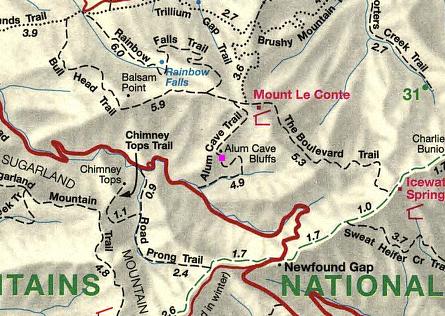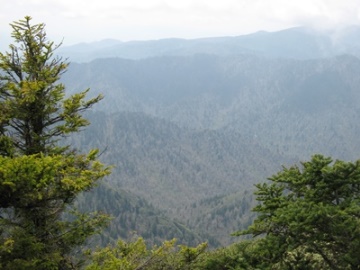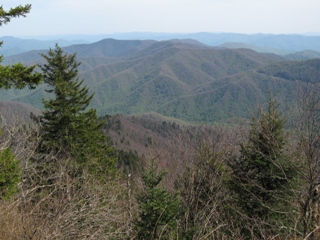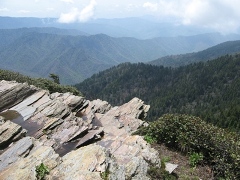
Mt. LeConte (via Boulevard Trail) Highlights
- Trail Features
Panoramic Views
- Trail Location
Newfound Gap
- Roundtrip Length
15.6 Miles
- Elevation Gain (total)
3000 Feet
- Elevation Gain (per mile)
385 Feet
- Trail Difficulty
21.60
Strenuous
This strenuous hike is 15.6 miles roundtrip and includes 3000 feet of elevation gain.
Mt. LeConte (via Boulevard Trail) Description
From the Newfound Gap parking area hikers will begin their hike by traveling eastbound along the Appalachian Trail for 2.7 miles before actually reaching the Boulevard Trail.
Many people assume that because this hike begins at such a high elevation that this must be the easiest trail to the summit of Mt. LeConte. Don't be fooled. This is a very tough hike. The trail rises and falls many times as it crosses the ridgeline between Mt. LeConte and the main crest of the Smokies.
A steady climb over the course of the first two miles of this hike quickly leaves the crowds behind at Newfound Gap. For your effort during this portion of the hike you'll be rewarded early and often. At roughly two-thirds of a mile you'll enjoy a grand view of the North Carolina side of the Smokies. Hikers will also enjoy a wide variety of wildflowers that bloom at these elevations during the spring and early summer months.
Just before reaching the Sweat Heifer Creek Trail junction, roughly 1.7 miles from the trailhead, be sure to take in the outstanding views of Mount LeConte and Myrtle Point towards the northwest.
As you proceed along the Appalachian Trail you'll be traveling at elevations that hover around 6000 feet. Being at the highest point along this narrow ridge, with stunning views on either side of the trail, you'll feel like you're walking on the spine of the Appalachian Mountains.
At just over 2.7 miles from the trailhead hikers will arrive at the Boulevard Trail junction. Proceeding straight ahead from this junction would lead you to Charlies Bunion. Hikers should turn left here to continue towards Mount LeConte.
Less than a tenth-of-a-mile after turning onto the Boulevard Trail is the spur trail to the Jump-Off. Although it's not an official national park trail, it is marked with a sign. And though it has a few rugged sections, the route is easy to follow. If you still have the energy on your way back the stunning views from this vantage point are well worth the additional one-mile roundtrip hike.
After circling around the western flank of Mt. Kephart, the Boulevard Trail drops down to an elevation of roughly 5500 feet. The trail continues by traveling in a range of roughly 5500 to 6000 feet, until reaching the southeastern flank of Mt. LeConte where it begins climbing steeply towards the 6593-foot summit.
Roughly two-tenths of a mile from the summit hikers will reach a short spur trail that leads to Myrtle Point, one of two spots on the mountain that provide outstanding panoramic views (see photo on the left). I highly recommend hiking the additional two-tenths of a mile from this junction to take in the nearly 360-degree views from this vantage point. Myrtle Point is also the best location for sunrises on Mount LeConte.
Continuing another two-tenths of a mile past the Myrtle Point trail junction is the summit of Mt. LeConte, also known as High Top. You'll know that you've reached the highest point on the mountain when you reach the large cairn, or pile of rocks, just off the main trail on your left.
At 6593 feet, Mount LeConte is the third highest peak in the Smokies. However, measured from its immediate base to its highest point, Mt. LeConte can be considered the tallest mountain in the Eastern United States, rising 5301 feet from its base near Gatlinburg.
Unfortunately you won't have any views at High Top. As mentioned, there are two places on the mountain that provide panoramic views. In addition to Myrtle Point, the other place to visit for outstanding views is known as Cliff Top, which is near the LeConte Lodge, located three-tenths of a mile from the summit. Hikers should descend down the other side of the mountain and begin looking for one of two social trails that fork off towards the left. Either of these will lead you to Cliff Top, which is also the best location for sunset views (see photo above).
There is considerable controversy over which member of the LeConte family the mountain was named for. Most people, including the USGS, assume that Joseph LeConte, the famous geologist and charter member of the Sierra Club, is the man for whom the mountain was named for. However, that claim has been challenged in recent years. The authors of A Natural History of Mount Le Conte, and the Georgia Encyclopedia, both claim the name honors Joseph's older brother, John, who was famous as a scientist and as president of the University of California, at Berkeley.
One of the unique aspects about the hike to Mt. LeConte is the lodge and overnight cabins near the top of the mountain. Hikers will have the option of spending the night in one of the historic cabins on the site, which in total can accommodate up to 50 guests a night (you'll need to make reservations well in advance). For more information you can visit the LeConte Lodge website. Hikers may also want to note that the lodge now offers beverages, baked goods and sack lunches to day hikers.
The idea for the lodge came about when Paul Adams, an enthusiastic hiker and explorer, led an expedition up the mountain with some dignitaries from Washington to show them the rugged beauty of the Great Smoky Mountains, and to help promote the cause for national park status. The group spent the night in a large tent. The following year Adams would build a cabin on that same spot, which eventually led to the establishment of the LeConte Lodge. Adams is also credited with helping to blaze the trail from Alum Cave to the summit of Mount LeConte.
Mt. LeConte (via Boulevard Trail) Map

Directions to Trailhead:
This hike to Mt. LeConte in the Great Smoky Mountains begins from the Newfound Gap parking area. To reach the trailhead from the Sugarlands Visitor Center near Gatlinburg, drive 13 miles south along Newfound Gap Road to the Newfound Gap parking area. From Cherokee, on the North Carolina side of the Great Smoky Mountains, drive 20.2 miles north to reach Newfound Gap.




